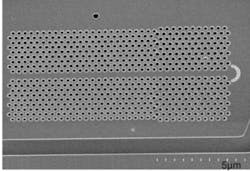Photonic-crystal laser leverages quantum-dot layer
Researchers at the University of Southern California (Los Angeles, CA), the University of Texas at Austin (Austin, TX), and the University of Central Florida (Orlando, FL) have demonstrated the first edge-emitting photonic-crystal (PC) nanocavity laser. In addition to edge emission, which is important to building high-density planar photonic integrated circuits, the PC laser also has a small mode volume, high quality factor, and high collection efficiency, unlike surface-emitting PC and distributed-feedback lasers.
A PC double heterostructure forms the laser cavity and consists of several segments of single-line-defect PC waveguides in triangular lattices. The devices were fabricated in a 220-nm-thick gallium arsenide membrane embedded with five layers of indium arsenide quantum dots as the active material. The lattice constant, a, is 343 nm in the cavity and 335 nm in the mirrors. Mirror lengths are 13a and 9a, and cavity length is 2a. An output waveguide with a = 351 nm is butt-coupled to the shorter mirror and a half-ring scattering structure is added to facilitate light collection. Pumped from the top by an 850 nm laser diode, the PC laser emits at approximately 1330 nm. Contact Tian Yang at [email protected].

